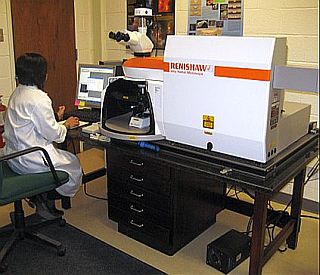Research facilities
We maintain a suite of sample preparation and analytical tools which are routinely used for fundamental research in geochemical, geophysical, mineralogical, crystallographic, structural and microstructural investigations of earth and planetary materials.
In-house PASSC Analytical Services
Renishaw inVia micro-Raman spectrometer

The micro-Raman (acquired 2007) is equipped with a reflected and a transmitted light microscope. It's useful for chemical identification, characterization of molecular structures, effects of bonding, environment and stress on a sample.
It can rapidly distinguish mineral polymorphs (e.g., kyanite, sillimanite). A micro-precision sample stage permits long-duration mapping.
The micro-Raman is housed and operated by the Planetary and Space Science Centre (PASSC). Contact Dr. John Spray for more information: 506-453-3550 or Email John.
For Students: Download the Authorization form and bring it with your samples signed by your supervisor.
Hitachi SU-70 Field Emission Gun (FEG) SEM
- Ultra-high resolution scanning electron microscope for imaging and materials characterization at the nanometre scale.
- This instrument is equipped with a variety of detectors for compositional, textural, and crystallographic imaging.
Geophysical equipment
- Geometrics Geode 36 channel, 24 bit exploration seismograph
- Custom-made preampliers and cables for seismoelectric measurements
- Sensors and Software PulseEKKO Pro Ground Penetrating Radar (GPR) (with 50 MHz, 100 MHz, and 250 MHz antennas)
- Lippmann electrical resistivity imaging (ERI) system (resistivity meter with eight 24-electrode switchboxes)
- Three Leica VIVA GS10 and GS15 RTK GNSS receivers
- GEM Systems GSM19W Overhauser-type magnetometer/gradiometer
- Geometrics G-856A proton precession magnetometer/gradiometer
- APEX Parametrics MaxMin I-9 Horizontal Loop EM system
- Geonics EM31 terrain conductivity meter
-
Sodin gravity meter
Geophysical software
- OASIS Montaj (gravity and magnetic data processing/interpretation)
- VISTA for Windows (seismic and seismoelectric data processing)
- Kingdom Suite seismic reflection interpretation package
- EKKO_View Deluxe (ground penetrating radar data processing)
- RES2DINV (inverse modelling for 2D resistivity ERI surveys)
- DCIP3D (inverse modelling for 3D resistivity surveys)
-
Surfer (general purpose gridding and mapping)
Electron and Light Microscopy at UNB MMF
Research in the Department of Earth Sciences Dis supported by in-house electron microbeam instrumentation and a large collection of microanalysis infrastructure centrally located and managed by UNB Microscopy and Microanalysis, a regional facility providing microanalytical and spectroscopic services.
The MMF is a regional facility provide imaging and analytical services to the University of New Brunswick, other universities, government and industry.
The facility houses three electron-beam instruments (SEM, TEM/STEM, Electron Probe), a confocal scanning laser microscope, digital light microscopes, an X-ray micro CT and a flow cytometer.
Access to the instrumentation is on a 'first-come, first-serve' basis and users pay an hourly instrument rental fee. Users have the option in being trained to operate the equipment themselves or in employing the services of the staff of the MMF.
The MMF offers training on all of the instruments and in advanced analytical techniques: EDS, WDS< EELS, EFTEM, electron diffraction, and numerous specialized sample preparation techniques. Special lectures in microscopy techniques are offered for classroom presentations or for groups of interested researchers upon request.
The UNB MMF lso supports a range of confocol (laser scanning) and digital light microscopes for materials characterization.
Experimental petrology
- Piston-Cylinder apparatus for high-P/high-T (to 25 kbar, 2000 C) phase equilibrium studies
- High temperature, controlled atmosphere furnace (1 bar, 1600 C)
- Hydrothermal lab for 1 bar to 2 kbar, 0-850 C phase equilibrium studies
- Rocking Bomb lab for 0-0.5 kbar, 0-300 C high volume solution geochemistry studies
- Various 1 bar 1000-1200 C ovens for sample preparation
- Low P (1-100 bar), room temperature flow through reactor for reactive transport studies
Sample preparation
- Hand splitting, jaw crushing, disc milling and mineral separation facilities
- Slabbing, grinding, and slab polishing and staining
- Wet chemical labs
- Sample dissolution facilities
Thin section preparation
- UNB Earth Sciences maintains one of the best thin section preparation facilities in Canada (A. Murphy & C. Nash)
- Covered, polished, doubly-polished, large-format and thick sections are routinely produced at exacting standards
Machine Shop
Our experienced in-house machinist, J. Chessie, is supported by a variety of tools that can be used for custom fabrication, modification and prototyping.
